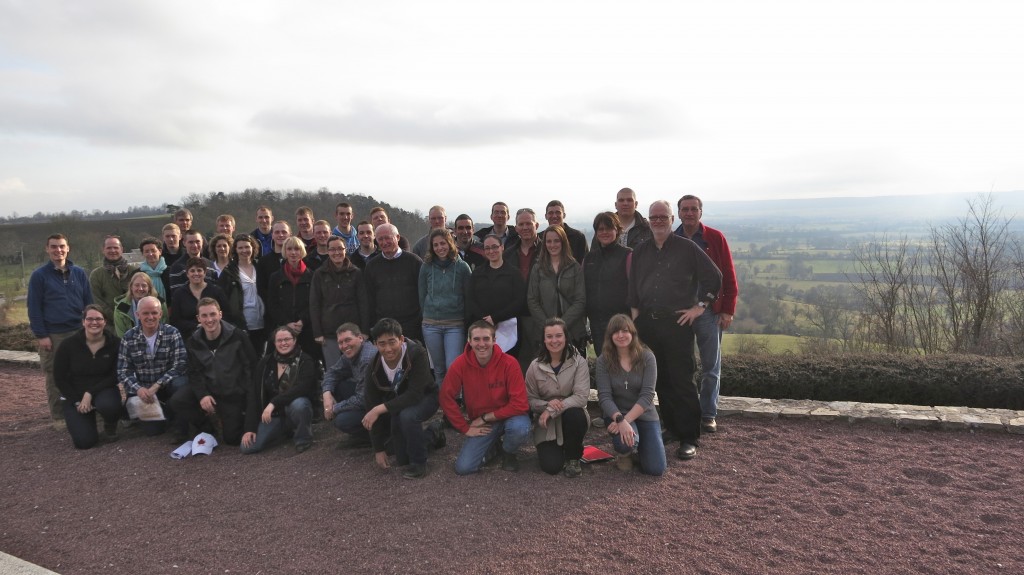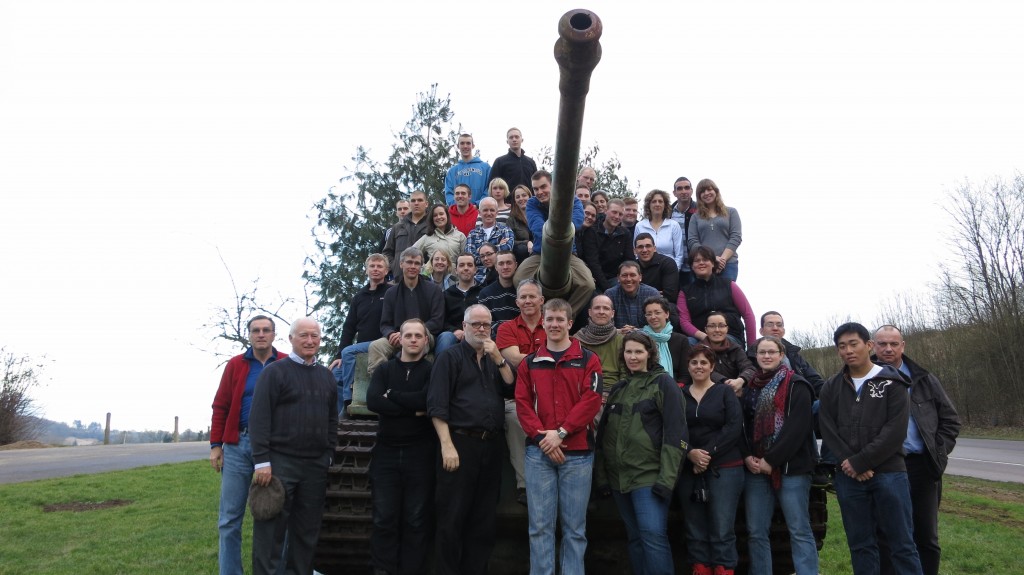
RMC Contingent Represents The Netherlands at Competition in Washington, D.C.
Article by 25779 OCdt (III) Scott Nantes
On Wednesday, February 15, while the rest of the college awoke to find that their dining hall had been converted into an airport hangar, the RMC Model NATO team was en route to Washington, D.C. Each year, Kent State University and Howard University organize a Model NATO conference to take place in Washington, with competing schools coming from across the United States, Canada, and Europe.
The model simulates five NATO bodies: The North Atlantic Council, the Defence Planning Committee, the Political Affairs Committee, the Nuclear Planning Committee, and the Euro-Atlantic Partnership Committee. Each university is assigned a NATO member state to represent. In the course of their preparation they develop an understanding of their country’s foreign policy, and the workings of NATO as a whole. This year RMC had the pleasure of the representing the Netherlands. The team was composed of Team Captain 25246 OCdt (IV) Max Reinthaler, 2IC 25779 OCdt (III) Scott Nantes, 25907 OCdt (III) Tom Neilson, 25759 OCdt (III) Patrick Sklavos, 26032 OCdt (II) Kyle Read, and 26349 OCdt (I) Derek Frank.
Upon arriving in Washington, the team had the privilege of being hosted for lunch in the National Press Club by Mr Michael MacMurry; the setting offered a beautiful view of Washington’s skyline. After being served lunch, the team hopped on the metro and made their way to the Pentagon for a tour of the famous facility. The team’s first day was brought to a close with incredible hospitality and a delicious homecooked meal prepared by 14961 Steve Frawley and Susanne Reinthaler-Frawley, parents of team captain Max Reinthaler.
After an easy first day, it was time for the team to don Scarlets and begin their work. This meant an opportunity to meet with the Embassy’s head of the political department, Mr Marcel de Vink and Colonel Jos Cousmans. Their insights and answers to the questions posed by the team proved to be the perfect capstone to the many hours of research that each team member had put into exploring the Netherland’s position on the topics relevant to their committee.
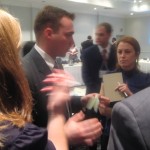 On the third day it was time for the competition to get underway. The team split up, with each member going to his respective committee. A number of contentious issues faced the committees, such as SMART defence, NATO nuclear policy, and the uncertain future of Afghanistan as many NATO member states begin to withdraw troops. Over the course of the following three days team members debated, negotiated, and made concessions in one area to strike a deal in another. It has been said that diplomacy is a 24-hour activity. RMC took this to heart and continued to develop friendships and connections outside of the conference room, invariably leading to more cooperation inside the conference room.
On the third day it was time for the competition to get underway. The team split up, with each member going to his respective committee. A number of contentious issues faced the committees, such as SMART defence, NATO nuclear policy, and the uncertain future of Afghanistan as many NATO member states begin to withdraw troops. Over the course of the following three days team members debated, negotiated, and made concessions in one area to strike a deal in another. It has been said that diplomacy is a 24-hour activity. RMC took this to heart and continued to develop friendships and connections outside of the conference room, invariably leading to more cooperation inside the conference room.
In keeping the tradition of success at this competition, each RMC delegate was elected by his peers as the Top Delegate in Committee with RMC as a whole winning the Best Overall Delegation. This success was possible only through the months of hard work put forward by each team members and through the consistent support and mentorship offered by Major Ian Rutherford.
It is important to note that it is only through the financial support of the RMC Foundation that this trip has been made possible year after year. This trip allows team members to develop an academic understanding of the issues at hand, as well as the ability to apply negotiation skills that will be invaluable as an officer in the Canadian Forces, regardless of element or trade. Furthermore, it allows RMC to project a positive image internationally given the legacy of success that the team has established at this competition.
______________
The 2012 Battlefield Tour from a Cadet’s Perspective
Article by 25383 OCdt (IV) Michael Akey
Hello my name is 25383 OCdt (IV) Michael Akey and the following is my personal day by day journal of the 2012 Battlefield Tour of France and Belgium. I have not listed every single event that took place as there are too many of them to list. Again these are my personal notes that I made, and I am sure each Cadet made different points and observations that I might not have had or did not think of. If there are any historical mistakes or spelling I apologize I have tried to keep this as accurate as possible. I hope that this peaks some of the 3rd years and 2nd years interest to think about applying next year as it is a great opportunity to learn about Canadian Military History.
Day 1 Feb 18 (Sat)
• 13:00hrs assemble at the front of Fort LaSalle and get on the bus
Follow here for nine day diary…
• 17:00hrs arrive at Pearson airport in Toronto-some of the Cadets had either girl friends or family members waiting there to say goodbye before passing customs
• 20:15hrs our flight has been bumped back by 3 hrs and our flight is suppose to leave at 23:00hrs
• With the extra time OCdt Allan and myself go to one of the restaurants within the airport to grab some food and watch the hockey game (Toronto lost 6-1 to Vancouver)-big surprise in seeing Toronto lose (not that I like Vancouver much either)
• 22:45hrs we board the plane and I have an aisle seat and watch a couple of movies
• People tried to sleep on the plane but some were unable to sleep and are very groggy getting off the plane
Day 2 Feb 19 (Sun)
• 12:40hrs we arrive in Paris and depart for the Somme battlefields
• We stop for a quick breakfast, everyone is very tired and needs more sleep but we cannot waste any more time because of the delayed flight incident. The food we get is from a truck stop as we try to catch up on the 3 hours that we lost from the flight being late
• 15:30hrs we hit the Lochnagar Crater which is huge, we estimated about 60-80 meters deep and about 80-90 wide, very steep and very muddy
• The Crater was suppose to build up a hill to cover the allies and would have been blown up moments before the battle was suppose to commence on the 1st of July 1916
• The crater caused a 400ft high explosion of dirt and debris (probably scared a lot of Germans who were near it)
• The tunnel for the crater is over a 100m in length stretching from just before the Allies front trenches, we cannot see it because the explosion caved it in
• The Somme area has a lot of high rolling hills that reach a very distinct peak which creates a overlapping view of the region
 • 16:30hrs we visited Beaumont Hamel
• 16:30hrs we visited Beaumont Hamel
• The weird thing at Beaumont Hamel is how extremely quiet it is, it is a very beautiful area
• The area is still marked with craters that have been grown over by the grass and some tree’s
• The remarkable thing here is that the trenches which for the most part in still intact give us a great representation of World War One fighting
• Also the trenches and the scenery shows us the importance of positioning in an engagement as the soldiers here are in plain view of the enemy and the NFLD soldiers were killed before reaching the front lines which were only 250m’s from the enemy’s front lines
• 17:10hrs We visit Thiepval which is a British monument for the battle of Somme
• The monument is large and overlooks the Somme valley and was very beautiful as the sun set
• The eerie part here is that the beauty of the hillside is surrounded with death
• 18:00hrs we visited several small monuments near Courcelette
• 18:40hrs we visited the Adanac Cemetary (which is Canada spelt backwards), this was one of the last sites of the day and was very sad to see as the sun set in the distance much like it had for the soldiers that lie in the cemetery. The bag pipes were played and it was a great way to end the first day of the tour.
• 20:00hrs Arrive in Arras, go out for supper and I tried some horse, it was actually really good and I would try it again if it came up on the menu (sorry to everyone who loves horse, but it tastes a lot like hamburger meat)
Day 3 Feb 20 (Mon)
• 7:00-8:00hrs eat Breakfast and depart for the day, today most people are in good spirits after shaking most of the jet leg off from the day before
• 8:40hrs We visit Mont Saint Eloi, which is a huge abbey that is overlooking the Vimy area, it is a very distinct monument and for the soldiers that were in the area it would mean the end of safe passage as enemy artillery would very often pick soldiers off after this line of passage
• This would have been the area of resupply and headquarters for the battle of Vimy
• The abbey on the hillside could be seen for miles and makes it a very distinct and significant monument, which is the reason why the Germans tried to destroy it
• The monument itself was partially destroyed and is under construction to rebuild it to its former glory when we visited
• 9:00hrs stop in a field and look at the old lines of the trenches and where the French would have had their front lines in 1914
• The area is very flat with rolling hills, and the abbey is to the South of where we stopped
• 9:30hrs stopped off at the German Cemetery Neuville-St.Vaast
• The cemetery is literally row upon row of crosses, and the sad part is that each cross has 4 names on each one, with only a name, and date of death and a rank of the soldier listed
• Very weird to see a German grave site in France
• We often forget that our enemies also take casualties, but we must remember that they also are fighting and dying for their country as well, even if we disagree with it
• 10:25hrs visited the big French grave site that all people in France must come and see during their schooling for elementary school
• 12:24hrs head over to the Vimy Crater system and the tunnels that would have been used to tunnel and blow up the mines before the commencement of battle
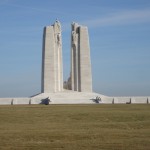 • 13:15hrs visited the actual Vimy Monument, the one that you usually see in textbooks, but to see it in person was breath taking and a sight I will never forget
• 13:15hrs visited the actual Vimy Monument, the one that you usually see in textbooks, but to see it in person was breath taking and a sight I will never forget
• The actual ridge is a lot bigger than you think; it is simply a big flat rolling hill that just continues to go up and ends very quickly, but the scenery and view looking down the ridge is something that you never forget, especially since they clear it to show the view of what the Canadians would have gone through
• Very important aspect for strategy as from the hill you can see in a full 360 degree
• 14:25hrs we ate at small bistro near Vimy, it had a large fire place and a lot of beer steins made from artillery pieces and shells from the surrounding area
• 15:38hrs we go to Farbous Woods where one of the German gun batteries that would have fired on Vimy ridge during the battle sits
• The view from the other side of Vimy Ridge really emphasizes the importance of the hill as it has a distinct view on both sides and forced the Germans to pull back to the next big ridge several km’s away
• 16:00hrs we start our trip towards Belgium
• 16:45hrs we arrive at the Belgium border, and much to my surprise being the only person who is not asleep there was no border crossing or anything, I was surprised and a little bit upset by this as I wanted my passport stamped by the Belgium custom officers
• 17:00hrs we arrive at our hotel and drop our stuff off
• Myself and OCdt Allan quickly run to the town center to pick up batteries for his camera which has chewed up several sets already and pick up some Belgium chocolate. The chocolate was amazing. I was happy that for once the rumours about something were true, as Belgium chocolate is delicious
• 20:00hrs we went to the Menin Gate ceremony which is held every evening at 20:00hrs no matter what the weather conditions are. The gate itself is huge and holds the names of all the common wealth soldiers that died in Belgium during World War One. There are a lot of Canadian soldiers listed here
• 20:20hrs we head again into town for supper and realize that many of the stores are shut down. We are surprised by this, but then find out it is a holiday in Belgium; we never find out what the holiday is however. I ordered some food; what I ordered I had no idea as I could not pronounce its name or remember its spelling, but it wasn’t very good, and ended up eating other people’s food as they had ordered pasta.
Day 4 Feb 21 (Tues)
• 7:00hrs everyone is up and ready, and much like the day before everyone is in high spirits
• 8:20hrs we arrive at a grocery store, I have collected 5 Euro’s from everyone and with a small group we go in and grab some food for a potluck type lunch. We buy lots of cheese and bread and meat and one or two boxes of wine and water for something to drink. We bought what we thought would be enough food (it wasn’t as we found out). We also found out that the bread that we bought was not fully cooked and some people did not like it, I personally just thought that it was really doughy bread and liked it. Oh well cannot make everyone happy with my food choices
• 8:40hrs we go to Essex Farm were John McCrae would have written his famous poem In Flanders Fields; it was a very moving place and had a huge plaque to commemorate his poem. There was also a bunker there. The bunker had been built later on, but at the time it would have just been sandbags.
• The canal was right beside it, which made the Essex Farm a great collection point for wounded personal as boats would have been able to carry a lot more people then horses
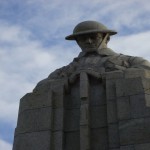 • 10:15hrs we went to the Ypres Salient and Saint Julien cemetery where the statue of the Canadian soldier is. We did something different at this spot; we went into a field and got down on our stomachs or prone position for all the army personal. It was on our stomachs that we could not see anything beyond a small hill 100m’s in front of us, and this struck home realizing to stand up would mean death and to be this low in the dirt would be so difficult to direct troops and maintain composure especially if under fire or while being gassed
• 10:15hrs we went to the Ypres Salient and Saint Julien cemetery where the statue of the Canadian soldier is. We did something different at this spot; we went into a field and got down on our stomachs or prone position for all the army personal. It was on our stomachs that we could not see anything beyond a small hill 100m’s in front of us, and this struck home realizing to stand up would mean death and to be this low in the dirt would be so difficult to direct troops and maintain composure especially if under fire or while being gassed
• 11:38hrs we went to the Tynecot war cemetery where there are over 12,000 bodies buried. This is also where the battle for Passchendaele occurred in 1917. Out of the 12,000 graves located at Tynecot over 3000 of them are unknown and another 2000 are only partially known and in addition to that over 30,000 names are on the walls of the dead that were never found
• Here it was literally a field of graves for as far as the eye could see, it was a very somber place
• The actual battlefield of Passchendaele much to my surprise was very small in comparison to what I thought it would be, I thought it would be much bigger then what it was. The reason why I thought it would be bigger was that nearly 16,000 Canadian soldiers died in the battle
• The land itself was very low lying and it brings home the point that it could turn into a killing zone that was once muddy and destructive to all that fought there
• 13:50hrs finished our lunch and visited a church were Canadian and other Allied soldiers would have gone if injured or in reserve, most of it was underground as the church had been destroyed but was under reconstruction at the time of our visit
• 14:15hrs we stopped off at a cemetery where OCdt Lane’s Great Grand Uncle was buried. He gave us a short bio and concluded with a very nice prayer
• 17:05hrs left Belgium and headed back to France
• 18:11hrs visited Hangurd Wood, which was very close to the Amiens battlefield and we got to see the grave of a VC winner, it was a very beautiful site especially with the sun setting on the hillside next to us
• 20:15hrs arrived at Dieppe, but it was very dark and we could not see much. We went to supper and we tried some sea food, but this was not the normal sea food that we think of, it was much more bread and fish oriented, and I did not like it that much, but the desert was great, it was Crepes which as OCdt McGregor will tell you is amazing
Day 5 Feb 22 (Wed)
• Our hotel was right beside the beach and beside the a huge Chateau on the side of a hill in Dieppe, I knew that we were close to the beach but I did not think that we were that close when we came last night
• 8:15-11:00hrs we walked the beach at Dieppe, it was very difficult to do because of the rocks, it took a couple of us a really long time to run up the beach and we were not carrying anything more than our backpacks, think of rucksacks on our back
• We went to the far side of the Dieppe landings to a place called the Hump, which would have had an old French tank dug in for a German battery position and the only reason it stopped firing the morning of the raid was that it ran out of ammunition
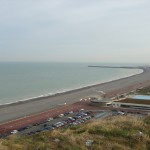 • We went back to the other side of Dieppe landings to the Chateau and from here we saw the entire beach and the view that the Germans would have had on the morning of the attack. From this view it was hard to believe that anyone survived the raid. Difficult to understand how the Allies were really that naive to ever attack here, as there were huge cliffs overlooking both sides of the beach where the Allies would have had to have stormed the beaches, no wonder it was a massacre
• We went back to the other side of Dieppe landings to the Chateau and from here we saw the entire beach and the view that the Germans would have had on the morning of the attack. From this view it was hard to believe that anyone survived the raid. Difficult to understand how the Allies were really that naive to ever attack here, as there were huge cliffs overlooking both sides of the beach where the Allies would have had to have stormed the beaches, no wonder it was a massacre
• The Chateau itself was very beautiful and had a lot of great scroll work
• 11:00hrs saw us in Pourville where other Canadian soldiers would have landed during the Dieppe raid. We stopped at the top of a hill which overlooked the entire beach, again it would have been very scary to have seen this the morning of the attack as you knew that Germans would have been up there waiting to shoot at you
• 11:29hrs went down to the bridge in Pourville, to see where the Canadian regiments would have landed, both sides of the beach are surrounded by huge cliffs overlooking the entire beach and rolling hills up through the town. This is the only place really where Canadians really got any momentum
• Hearing the ocean here is not like it is anywhere else I have heard it; the rocks here force the water down in way that it sounds like millions of crabs clacking their claws(or whatever they are called) all at once, it is a most distinctive sound that I will remember for the rest of my life
• 12:30hrs we went to Puys which is other beach that the Canadians would have landed at during the Dieppe raid. To my surprise I had thought that the beaches were connected but they were not, and had a distance of 2-3km’s between them
• The cliffs here surround a very small beach, and we realized that there were only one or two paths that the Canadians could have taken, and both would have been covered by machine gun nests
• Here at Puys there is no cover, the cliffs go straight up and leave no shelter from the other cliffs making it a perfect killing zone for the Germans
• Again we ran along the shore to see how difficult it was; the difficulty in running was so hard that we had to stop several times in order to catch our breath or pick ourselves up after we had fallen which was often. I cannot imagine trying to run up the beaches with no cover with 100lbs of kit on while being shot at, it’s just unfathomable
• 14:45hrs visited the Dieppe War Cemetery, the sayings on some of the graves were really touching, one grave had written on it Truth Duty Valour
• OCdt Demers pointed out a grave to me with the same last name as mine, and since I do not have common name deduced that it was a relative of mine (upon further research he was from my hometown and would be a relative of mine, I am currently trying to find out more on him)
• Sergeant S.H Akey, Killed Oct 15, 1944, Royal Hamilton Regiment of Canada, hometown was Pointe Anne (which is now a part of Belleville Ontario)
• OCdt Couturier read a poem, I don’t think there was a dry eye at that point
• Just before leaving I went back to Sergeant Akey’s grave and said a quick prayer
• 16:40hrs we arrived at Caen and had supper, it was a really good; a group of us then went to an Irish Pub. We got some dirty looks as we sang the song Summer of 69 by Bryan Adams, but that didn’t bother us much; we just kept singing till the song was over
Day 6 Feb 23 (Thurs)
• 10:00hrs we have visited a couple of the D-Day Airborne landings and their objectives, such as the small bridges that are all over Normandy
• 11:30hrs went to the Merville Battery that would have been able to hit the beaches at Normandy during the D-Day landings. This battery was not as big as originally thought but the Airborne regiments needed to take them out because they did not know until after taking them that they were smaller than predicated (Allies thought that there were 155mm guns but it turned out to be old Polish 100mm guns)
• 13:30hrs visited Pegasus Bridge, where the gliders landed basically on the bridge, very cool story as to how perfectly the pilots of the gliders put them on the objective
• At this point OCdt Allan my roommate figured out he had lost his wallet; we looked for it at the Bridge site and did not find it (we never did find the wallet)
• 14:00hrs Arrived at Juno beaches, which are very different from the beaches at Dieppe, lot of sand and a lot less rocks cover the beaches as well no cliffs covering the beaches
• We saw the house that everyone see’s in the landing clip from Juno beach (the Queens own Rifles House-thought to be the first house liberated in France after Dunkirk in 1940)
• Again the interesting point that I found on this trip with regards to the beaches was that they were all separated by a couple of km’s and each beach was very much similar unlike Dieppe beaches
• The tide would have been really close to the actual sea wall for the Canadian beaches which made it easier for the Canadian’s to storm the beaches
• 18:30hrs visited Omaha Beach. The reason why the American assault was decimated was that it had no cover when approaching the beaches, the soldiers were in the open for over 800m’s and it would have been like a World War One assault in an open field covered by machine gun nests, no wonder the Omaha Beach took such great casualties
• Unlike the Canadians, the Americans wanted to have it so they could avoid mines when driving in on the landing craft so they choose to attack with the tide so far away, so unlike the Movie Saving Private Ryan they would have been further back, but they would have been completely in the open for almost a km with direct machine gun fire
• Dr. Heffernan and Dr. Allan told me that the for a Pillbox to be destroyed it would need a direct hit from a 5000lbs shell(which rarely ever happened)
• As well many of the pillboxes had these weird indents and patterns on them and myself and none of the stuff could not figure it out, someone had come up with the theory that these indents were made to allow the pillbox to take hits and only have some of it chunk off instead of being destroyed (still have not found out the answer to this)
Day 7 Feb 24 (Fri)
• 8:57hrs visited the Abbey where the soldiers that were captured on or shortly after D-Day were murdered, these are the soldiers that were interrogated and then shot in the Abbey by the SS. The abbey itself is a very beautiful place and unlike a lot of places where we visited this one was full of birds chirping and was very lively and grown up with trees and bushes and shrubs
• 13:00hrs we have visited several small places where the battle for Normandy really amped up, including Operation Totalize and Operation Tractable
• 15:00hrs we visit the Falaise Gap where the Germans were trying to escape capture after the Allies have trapped them in Normandy, very beautiful site which has a great view of the whole area
• 16:30hrs we visit a German Tiger Tank which is huge and is the final official end to the Battlefield Tour portion of the trip
Day 8 Feb 25 (Sat)
• Today is our day in Paris and we leave from Caen to go to Paris, but along the way our bus breaks down and we lose about 3 hours
• 13:00hrs we arrive at the hotel, after touring the city for a bit to get all of the major sites in, and to also get a bearing of where we are and how big the city actually is, we hit most of the big sites along the way to the hotel
• 13:10 we in our own groups head out into the city to tour and visit all of the sites, I go with OCdt Allan, McGregor, Ghanam and Brytus
• We have a huge supper and then go back to the see the wonder sites of Paris
• There is so much I could say about Paris, but to keep everyone intrigued I will just say that to fully enjoy it, you have to see it in person as my words would not give justice to the beauty of some of the historic sites that the city has to offer
Day 9 Feb 26 (Sun)
• Some of us are late for the bus this morning as our wakeup call never happened, luckily for some they brought and used alarm clocks,
• 11:30hrs we get on the plane and head back to Canada
• 18:45hrs we arrive back at RMC fully completing the Battlefield Tour of 2012
Layout by 25366 NCdt (IV) Mike Shewfelt




